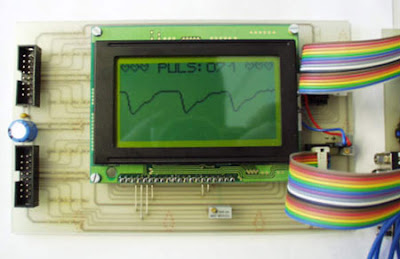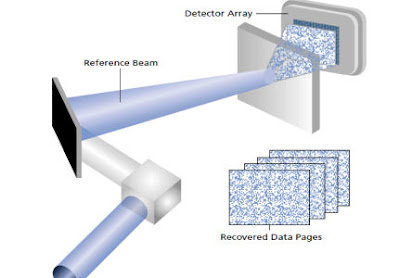skip to main |
skip to sidebar
 Did you know that The human heart can be measured optically. The heart beat with the varying blood pressure leads to a measurable change in the visual content of peripheral blood vessels. This is as good at the finger detect. There are two project work available, which were so far advanced that the optical signal pulse seized on a liquid crystal display graphically. Both works have been with a microcontroller PIC16C74 to collect and visualization of the signals.
Did you know that The human heart can be measured optically. The heart beat with the varying blood pressure leads to a measurable change in the visual content of peripheral blood vessels. This is as good at the finger detect. There are two project work available, which were so far advanced that the optical signal pulse seized on a liquid crystal display graphically. Both works have been with a microcontroller PIC16C74 to collect and visualization of the signals.
Pulse measurement in a light
The light source was a red LED superhelle. The finger penetrating light was a light-frequency converter TSL230 detected. The period of the signal from the TSL230 was using the capture of the micro-controller unit with an accuracy of about 15-bit recorded. Through digital filtering 50Hz interfering signals were suppressed and the pulse signal extracted.
Pulse measurement in reflection
For the lighting of the skin's surface, an infrared LED used. the censor use PIN photodiode. With an analog circuit filters were equal light and high frequency interference signals eliminated. The signal was pulse by the A / D converter of the microcontroller with 8-bit digitized.
[Link]
 Measuring SWR at VHF/UHF frequency was never a fun. Most radio amateurs just assume that their 50 ohms cable is matching a beam or GP.
Measuring SWR at VHF/UHF frequency was never a fun. Most radio amateurs just assume that their 50 ohms cable is matching a beam or GP.
LCD SWR Meter presented here meet many simple task using a microcontroller PIC16F88. The very basic purpose to make this project is to encourage radio amateurs to build their own High Quality LCD SWR Meter at low price, instead of buying expensive ready made units.
[link]

This decoder is fed by a RDS demodulator IC (or tuner) which has RDDA (data signal) and RDCL (clock signal) outputs.The microcontrolller is an Atmega168 clocked on the external 4.332MHz crystal from the RDS demodulator. TDA7330B RDS demodulator IC from STMicroelectronics to be used in this project. The TDA7330B is connected to the Atmega168 with RDDA connected to PD4 (on PORTD) and RDCL to INT0 (PD2).
The software in the Atmega168 is able to decode the following RDS data:
* Programme Identification code (PI: 0x83C7, Detected new station.)
* Program service name (PS: RADIO538)
* Programme Type code (PTY: 0x0A, Pop Music.)
* Traffic Programme Identification code & Traffic announcement code (TP&TA: 0x01 0x00, Traffic announcements available on this station and maybe via EON on another station.)
* Music Speech switch code (MS: 0x01, Music is being broadcasted or station does not use MS flag.)
* Decoder-identification control code (DI: 0x01, Stereo, Dynamic PTY.)
* Alternative frequency codes (AF: 0x98, 102.7MHz.)
* Linkage Actuator (LA: 0x00)
* Extended Country Code (ECC: 0xE3)
* RadioText (RTA: Radio 538 = Randstad (Zuid) 102.7 FM)
* Clock-time and date (CT: 0x1A53CD844, UTC 2006-07-02 (MJD 53918) 13:33:00 +02:00, TIME 15:33:00)
Download for document, source code here (zip)
[link]
 Parallel interfacing LCD with MCU at least need 6 I/O pins (4 bit mode) and maximun can up to 11 I/O pins (8 bit mode). The I/O pin can be cut down to 3 pin by serial iterfacing using shift register. They were few shift register can be used such as 74HC164, 74HC595, CD4094 and any compatible 8 bit shift register. Before you attempt to do serial interfacing, it is good pratice to familiar with parallel interfacing. You can find many reference from internet.Following diagram show the serial interfacing Hitachi compatible 2 X 16 LCD modules with Pic16F84 or Pic16F628 MCU.
Parallel interfacing LCD with MCU at least need 6 I/O pins (4 bit mode) and maximun can up to 11 I/O pins (8 bit mode). The I/O pin can be cut down to 3 pin by serial iterfacing using shift register. They were few shift register can be used such as 74HC164, 74HC595, CD4094 and any compatible 8 bit shift register. Before you attempt to do serial interfacing, it is good pratice to familiar with parallel interfacing. You can find many reference from internet.Following diagram show the serial interfacing Hitachi compatible 2 X 16 LCD modules with Pic16F84 or Pic16F628 MCU.
Download documentation and source code for serial interfacing LCD with PIC here (zip file)
[link]

The Net Radio created by Bertrand Achard. The Net Radio enables you to listen to MP3 streaming radios that are broadcast over the Internet without a PC. MP3 streams are received through an Ethernet link, decoded by an on-board MP3 decoder, and then output as audio through a 3.5-mm stereo jack. The user-friendly design includes easy-to-use switch buttons and a color LCD. The Net Radio is designed around an ATmega64L RISC microcontroller that provides ample memory. The ATmega64L was also chosen for its low power consumption, which enables the Net Radio to be interfaced with low-power commercial devices.
Link : Source | Abstrak | Entry
 Project description:Another cool project from course ee476 Cornell university that used an Atmel AT90S8535 microcontroller for Ping-Pong project. It used the ADC on the chip to read the positions of the potentiometer controllers (see Hardware). The game is for two player simultaneous play, although it is also challenging and fun to play against your self using both controllers.Link : Ping-Pong using ATmega8535
Project description:Another cool project from course ee476 Cornell university that used an Atmel AT90S8535 microcontroller for Ping-Pong project. It used the ADC on the chip to read the positions of the potentiometer controllers (see Hardware). The game is for two player simultaneous play, although it is also challenging and fun to play against your self using both controllers.Link : Ping-Pong using ATmega8535
 The USB Audio Card project offers a better solution than going through the hassle of adding a new PCI audio device to a PC. A high-speed USB and a powerful ATmega162L-8PI microcontroller are the keys to an easier upgrade. A USB B-type-to-A-type cable is used to connect the audio card to the PC. Windows pretty much handles the rest of the work. With earphones connected to the card, you can listen to MP3 and WAV files. This cool project made by Havent ChenLink : USB Audio Card | Abstrak | Entry
The USB Audio Card project offers a better solution than going through the hassle of adding a new PCI audio device to a PC. A high-speed USB and a powerful ATmega162L-8PI microcontroller are the keys to an easier upgrade. A USB B-type-to-A-type cable is used to connect the audio card to the PC. Windows pretty much handles the rest of the work. With earphones connected to the card, you can listen to MP3 and WAV files. This cool project made by Havent ChenLink : USB Audio Card | Abstrak | Entry

Here is RF Remote control using microcontroller created by serasidis. There are two part in this electronic project : transmitter and receiver. The transmitter is constituted by AT90S2323 microcontroller and TLP434 RF transmitter module at 418MHz. the transmitter designed for battery economy use and safe transmition of the data. The receiver constituted by RF receiver module RLP434A at 418MHz, the microcontroller AT90S2313 and the 2 relays with can handle any electric (or electronic) device up to 10 Amps (the contacts of my relays are 10Amp at 250Volts).For antenna you can use a cable 30 - 35cm long.
Download here for documentation, firmware, source code and schematic.
[link]
 The goal of this work is to investigate the use of holographic techniques for information processing and transmission systems. Until recently information has been processed and transmitted mainly electronically. With the advent of optical fiber communications the monopoly of electronics has receded in the telecommunications field, but the domain of information processing is still dominated by electronic processors.
The goal of this work is to investigate the use of holographic techniques for information processing and transmission systems. Until recently information has been processed and transmitted mainly electronically. With the advent of optical fiber communications the monopoly of electronics has receded in the telecommunications field, but the domain of information processing is still dominated by electronic processors.
This thesis follows a top-down approach to the design of processors that integrate both electronic and optical components. It begins with the design considerations of a compact, rapidly reconfigurable opto-electronic processor, which possesses an optical bus in addition to the traditional electronic bus. The optical bus takes advantage of the massive parallelism that is afforded by optics and can be coupled to a holographic digital memory, allowing rapid reconfiguration of the device. The capability of rapid reconfiguration gives rise to a new computational paradigm, where the reprogramming of the device can become part of the computation. We suggest additional applications of this processor, namely as a smart reading head for large scale holographic disk memories. Finally we present novel algorithms that were developed specifically to take advantage of the additional capabilities of our processor. The next section is concerned with the wavelength and angular tuning of strong volume holograms, both in the reflection and 90-degree geometries. Since photons have no charge, we need to rely on their wave properties to manipulate them, both for long-range transmission, such as telecommunications, and short-range transmission, such as on chip interconnects. In this section we investigate how volumeholograms can be used to selectively redirect information bearing light beams.The final part of this thesis is concerned with material issues. Holographic recording of strong volume gratings is one of the most commonly used approaches, and photorefractive materials have a strong bearing on the overall performance of the final system.
Download this thesis
 Did you know that The human heart can be measured optically. The heart beat with the varying blood pressure leads to a measurable change in the visual content of peripheral blood vessels. This is as good at the finger detect. There are two project work available, which were so far advanced that the optical signal pulse seized on a liquid crystal display graphically. Both works have been with a microcontroller PIC16C74 to collect and visualization of the signals.
Did you know that The human heart can be measured optically. The heart beat with the varying blood pressure leads to a measurable change in the visual content of peripheral blood vessels. This is as good at the finger detect. There are two project work available, which were so far advanced that the optical signal pulse seized on a liquid crystal display graphically. Both works have been with a microcontroller PIC16C74 to collect and visualization of the signals.












